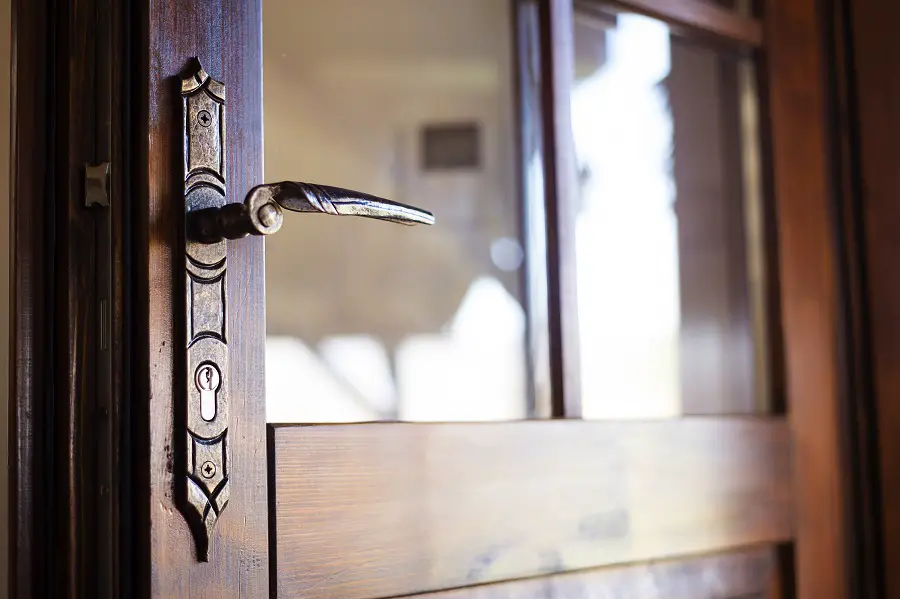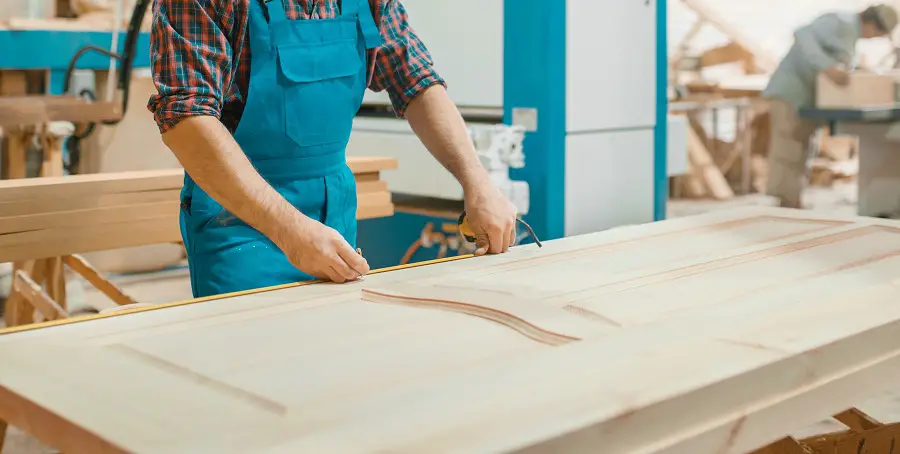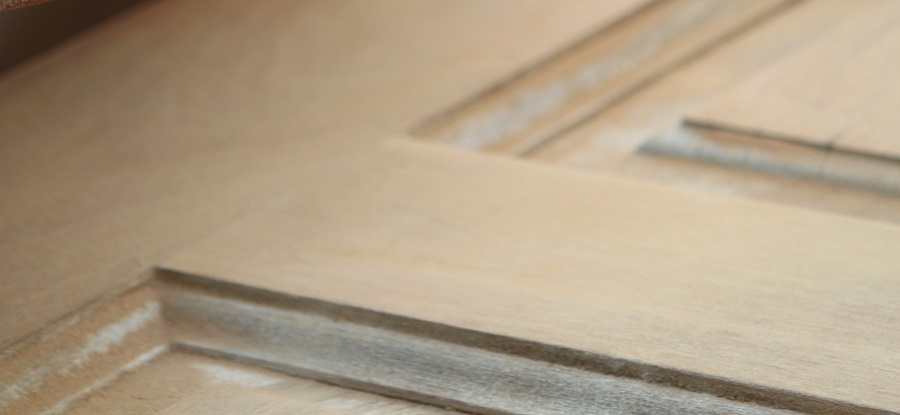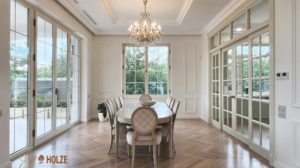Many who have solid wood doors complain that they tend to warp. They can no longer close because they become larger than the frame or no longer stay closed, they leave loose space at the top or bottom becoming a problem especially in cold weather, you start to see through the door where the pieces of wood are joined together and other such nuisances. And not infrequently, warping is accompanied by the appearance of cracks. After a while some defects disappear and the door returns to its original shape, but warping can remain permanent. Why do solid wood doors warp? A combination of 3 factors:
- inadequate humidity and its variation,
- the wood used to make the door,
- the constructive solutions chosen.
Let's take a look at how each of these factors influences the others and what you need to do to prevent their effects from having consequences.

How humidity affects humidity and what you can do about it
We always hear that wood moves, expands or contracts, that it can crack. All this happens because of moisture in the wood or in the wood's environment. When cutting, the moisture in the wood is high and takes time to be removed. This is the drying time - natural or artificial - needed for the wood to reach equilibrium humidity. This humidity is correlated to the region in which that wood will function. For the temperate region in which our country is located, the equilibrium moisture content is 8-12% for wood used indoors and 14-18% for wood used outdoors. When the equilibrium moisture content is reached, the dimensional variation caused by the outdoor moisture content no longer causes significant movement of the wood.
There are situations, however, when environmental humidity fluctuates more than normal. This can happen in winter, when the air in the house becomes very dry, or in rooms such as bathrooms and kitchens, where normal activities can lead to a significant increase in humidity. To restore the balance, if the air is dry, some of the water in the wood escapes and the wood shrinks. If, on the other hand, the indoor humidity is very high, the wood absorbs moisture to reach a new equilibrium with the environment and thus expand. The longer the elements, the greater the expansion and contraction. This is the case with solid wood doors. By simply increasing or decreasing the dimensions, the door can no longer close or open. And if the construction solution was that the elements were very rigidly fastened, the dimensional change turns into warping or cracking. That's why the solid wood trim of the door is never glued into the frame but is left to move freely.
Door warping can also be caused by water, not just moisture in the air. Persistent water on the floor, which can come from nearby flowers, condensation leaks into the wood and causes warping.
What can be done? Insulating the wood very well with finishing products, including on the edges, to prevent water from seeping in and out. Adopt construction solutions that allow movement, but also minimize movement (smaller elements). Avoid positioning water sources near doors or heat sources that would force water out. Use indoor humidity control systems.

Which wood is better and why
The wood from which the door is made is important both in terms of the species and the way it is cut. The wood for the door must not develop very strong stresses when there are variations in humidity because cracking or severe warping can occur. Therefore lime wood or that of resinous is commonly chosen for doors. Also from a species point of view, wood with large and very large pores is more prone to warping as humidity increases than wood with small pores or no pores (such as resinous wood). The pores are the way moisture enters or exits the wood. Large pores are difficult to block with finishes and therefore the risk of dimensional variation is higher in these species.
The way the timber was cut is also important. The log can be cut tangentially, radially or axially. The wood is more stable and less subject to warping when sawn parallel to, and as close as possible to, the trunk's central axis. With growth, stabilized, supporting wood accumulates towards the centre of the wood, and stabilized, feeding wood accumulates outwards. The latter is more open to absorption because that was its role, to absorb food.
Wood is an anisotropic material, non-uniform within the same species and even within the same trunk. It is more stable the more uniform it is and the fewer growth defects. The larger the elements used, the more care must be taken in their choice.
How constructive solutions and design influence
Doors have large surfaces and are only clamped on one side, so great care must be taken when choosing the design and constructive solutions. We have already seen that rigid clamping of elements can lead to warping, and the longer the elements, the greater the dimensional variation. Solutions must be adopted that do not encumber the door so that it can be supported by the chosen system. If reinforcements are used, they should be applied as evenly as possible on both sides of the door so as not to unbalance the door and should allow some play of the wooden elements. The finish should also be applied evenly on both sides of the door, i.e. the same number of coats should be applied. Although it may seem unbelievable, many of the warping of doors, as well as table tops or other large wooden objects, is due to the different number of coats on the two sides.
The solution that gets you out of trouble is to use laminated wood for making doors. It is enough to have a layer of wood (a core) placed perpendicular to the inside of the door to make it stable and inert. Industrialized wood, even if many consider it "less" wood, eliminates many of the drawbacks of solid wood. And the use of wide solid wood countertops for the faces will make the door look like a solid wood door.

What to do if your door is warped
When the solid wood door has warped, you need to see what has changed in the meantime. It is possible that if the modification stops the door will recover. It happens to me every winter. The house is old with very high doors. In winter, the humidity inside drops a lot due to radiant heating (with radiators) and the air becomes dry. The doors contract and it is harder to keep them closed. In spring, when they turn off the heat, slowly the doors recover and everything gets back to normal.
However, there are situations when the deformation of the door is irreversible. In this case repair is very difficult, sometimes impossible. If it is found that the warping is due to low humidity, you can try dampening them, followed by straightening. The door should be taken off the hinges and placed on a flat surface. Cover it with large, well wrung, damp towels and leave it for 20-30 minutes. Then place another door or a panel of the same size on top and put weights on top or clamp the whole thing in cleme. After 2-3 days it is checked and if an improvement is seen, the process can be repeated.
I hope the information is helpful. If you have any additions or questions, please leave them below in the dedicated space. I will certainly reply.




































I would like to ask you what could be the cause of the cracks on the edge of the cellular doors with lime frame.
Hello!
I assume you're referring to the lime frame. If there are cracks along the grain, the wood may not have dried well or the difference between its moisture and the environment the door is in is very high (the air is very wet or very dry).
If there are perpendicular cracks on the fiber in the paint on the frame, then it is the paint (too thick coat, drying too fast, incompatible materials, etc.)
All the best!